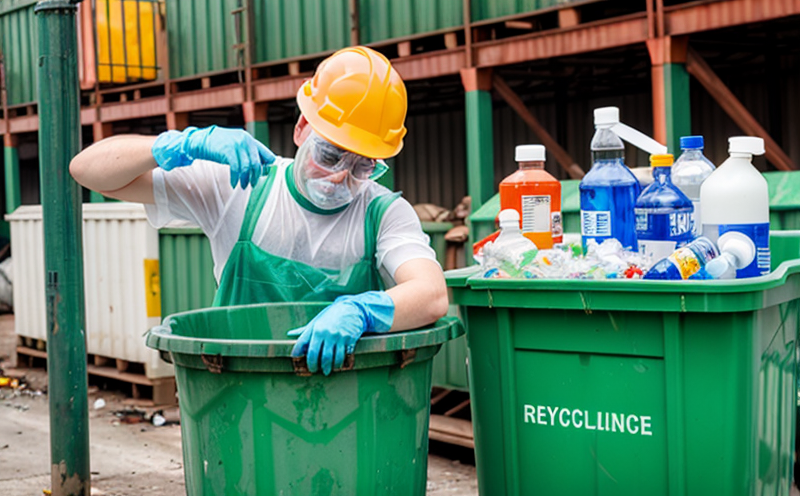USP 232 Elemental Impurity Testing in Waste Derived Products
The United States Pharmacopeia (USP) Chapter 232 provides a robust framework for assessing elemental impurities within pharmaceuticals and related products. When it comes to waste derived products, ensuring the safety of these materials is paramount, especially considering their potential use in new applications such as construction aggregates or soil amendments.
The goal of USP 232 testing is to identify and quantify trace levels of elements that may pose risks if present at higher than acceptable levels. This includes metals like lead (Pb), mercury (Hg), cadmium (Cd), arsenic (As), and others. Elemental impurities can arise from various sources including manufacturing by-products, environmental contamination, or the original waste material itself.
For waste derived products intended for reuse in applications where direct human exposure is possible—such as construction materials—the need to control elemental impurities becomes even more critical. USP 232 testing helps ensure that these materials meet stringent safety standards, thereby protecting public health and the environment.
The testing process involves several key steps: sample preparation, digestion of the samples to release elements into solution, and analysis using advanced analytical techniques such as inductively coupled plasma mass spectrometry (ICP-MS) or graphite furnace atomic absorption spectroscopy (GFAAS). These methods allow for precise quantification down to parts per billion concentrations.
Proper sample preparation is crucial; this may involve mechanical crushing, sieving, and homogenization of the waste derived product. Digestion solutions typically contain strong acids like nitric acid which break down complex matrices into simpler compounds allowing elemental impurities to be measured accurately.
The analytical results are then compared against established USP limits for each element being tested. Compliance with these limits ensures that the waste derived products meet regulatory requirements and can be safely used in specified applications without posing undue risks.
It is important to note that while this service focuses on elemental impurities, it does not address other potential contaminants such as organic compounds or pathogens which might also require separate testing. However, understanding the overall composition of waste derived materials through comprehensive chemical analysis remains essential for informed decision-making regarding their reuse.
- Sample Types: Commonly tested samples include construction aggregates (aggregate), soil amendments, and other industrial by-products.
- Analytical Methods: ICP-MS, GFAAS, inductively coupled plasma optical emission spectrometry (ICP-OES).
- Target Elements: Lead (Pb), Mercury (Hg), Cadmium (Cd), Arsenic (As), Chromium (Cr), Nickel (Ni), Selenium (Se).
Benefits
Implementing USP 232 Elemental Impurity Testing offers numerous advantages to stakeholders across the supply chain. For quality managers, this service ensures that waste derived products meet stringent safety standards before being repurposed or resold.
Compliance officers gain peace of mind knowing that they are adhering to international regulations and industry best practices when handling potentially hazardous materials. R&D engineers can leverage accurate elemental impurity data to develop innovative solutions for converting waste into valuable resources while minimizing environmental impact.
Rigorous testing also protects manufacturers from legal liabilities associated with non-compliant products entering the market. By demonstrating commitment to safety and sustainability, companies enhance their reputation among consumers who increasingly value responsible business practices.
Industry Applications
- Construction Industry: Waste derived aggregates may be used in road construction or as fill material for infrastructure projects. Ensuring these materials comply with USP 232 helps protect against long-term degradation caused by corrosive elements.
- Agriculture and Horticulture: Soil amendments made from waste materials must ensure they do not introduce harmful levels of heavy metals into agricultural soils, affecting crop yields and soil health.
- Environmental Cleanup Projects: Waste derived products can be used in contaminated site remediation efforts. Accurate elemental impurity testing ensures these materials are suitable for treating hazardous waste without exacerbating contamination issues.
International Acceptance and Recognition
The USP is one of the most widely recognized compendia of drug standards globally. The testing methods outlined in Chapter 232 have been adopted by numerous countries including Canada, Japan, and various European Union member states.
In addition to regulatory compliance, adherence to international standards like USP ensures seamless integration into global supply chains. This is particularly relevant for companies operating internationally or sourcing raw materials globally.
Compliance with these standards also enhances brand reputation by demonstrating a commitment to environmental stewardship and public health. It allows businesses to differentiate themselves in competitive markets where sustainability is becoming increasingly important.





